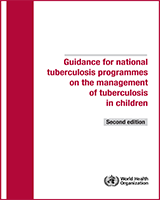When Do You Read a Tb Test
NCBI Bookshelf. A service of the National Library of Medicine, National Institutes of Wellness.
Guidance for National Tuberculosis Programmes on the Management of Tuberculosis in Children. 2nd edition. Geneva: World Health Organization; 2014.

Guidance for National Tuberculosis Programmes on the Management of Tuberculosis in Children. 2nd edition.
Show details
- Contents
Annex 3 Administering, reading and interpreting a tuberculin skin test
This addendum gives data on administering, reading and interpreting a tuberculin skin test (TST).
A TST is the intradermal injection of a combination of mycobacterial antigens that elicit an immune response (delayed-type hypersensitivity), represented by induration, which tin be measured in millimetres.
The standard method of identifying people infected with Grand. tuberculosis is the TST using the Mantoux method. Multiple puncture tests should not exist used as these tests are unreliable (because the amount of tuberculin injected intradermally cannot be precisely controlled).
This addendum describes how to administrate, read and interpret a TST using five tuberculin units (TU) of tuberculin PPD-Southward. An alternative to v TU of tuberculin PPD-S is 2 TU of tuberculin PPD RT 23.
Assistants
-
Locate and clean injection site 5–10 cm (2–4 inches) below elbow joint
-
Place forearm palm-up on a firm, well-lit surface.
-
Select an area gratis of barriers (east.g. scars, sores, veins) to placing and reading.
-
Clean the area with an alcohol swab.
-
-
Gear up syringe
-
Check expiry date on vial and ensure vial contains tuberculin PPD-S (v TU/0.1 ml).
-
Utilize a single-dose tuberculin syringe with a short (¼- to ½-inch) 27-gauge needle with a short bevel.
-
Clean the summit of the vial with a sterile swab.
-
Fill the syringe with 0.i ml tuberculin.
-
-
-
Insert the needle slowly, bevel up, at an angle of five–15°.
-
Needle bevel should be visible just below skin surface.
-
-
Cheque injection site
-
Afterwards injection, a flat intradermal wheal of 8–10 mm diameter should appear. If not, echo the injection at a site at least 5 cm (2 inches) away from the original site.
-
-
Record information
-
Record all the information required by your establishment for documentation (e.g. date and fourth dimension of test administration, injection site location, lot number of tuberculin).
-

Figure A3.1
Administration of the tuberculin skin exam using the Mantoux method.
Reading
The results should be read between 48 and 72 hours after administration. A patient who does not render inside 72 hours will probably demand to be rescheduled for another TST.
-
Inspect site
-
Visually inspect injection site under good light, and measure induration (thickening of the peel), not erythema (reddening of the skin).
-
-
Palpate induration
-
Utilise fingertips to observe margins of induration.
-
-
Mark induration
-
Use fingertips as a guide for marker widest edges of induration beyond the forearm.
-
-
Measure bore of induration using a clear flexible ruler
-
Place "0" of ruler line on the inside left edge of the induration.
-
Read ruler line on the inside right edge of the induration (utilise lower measurement if betwixt two gradations on mm scale).
-
-
Record diameter of induration
-
Practice not tape as "positive" or "negative".
-
Only tape measurement in millimetres.
-
If no induration, record as 0 mm.
-
Interpretation
Interpretation of TST depends on two factors:
- –
-
diameter of the induration;
- –
-
person's risk of being infected with TB and of progression to disease if infected.
Induration of diameter ≥5 mm is considered positive in:
- –
-
HIV-positive children;
- –
-
severely malnourished children (with clinical evidence of marasmus or kwashiorkor).
Induration of bore ≥ten mm is considered positive in:
- –
-
all other children (whether or not they have received BCG vaccination).
Causes of false-negative and false-positive TSTs are listed in Table A3.1.
Table A3.one
Causes of false-negative and imitation-positive tuberculin skin tests.
References
- 1.
-
Guidance for national tuberculosis programmes on the management of tuberculosis in children. Geneva: World Health Arrangement; 2006. (WHO/HTM/TB/2006.371) [PubMed: 17044200]
Copyright © World Health Organization 2014.
All rights reserved. Publications of the Globe Health Organization are bachelor on the WHO website (world wide web.who.int) or can exist purchased from WHO Press, World Health Organization, 20 Avenue Appia, 1211 Geneva 27, Switzerland (tel.: +41 22 791 3264; fax: +41 22 791 4857; eastward-mail: tni.ohw@sredrokoob).
Requests for permission to reproduce or translate WHO publications –whether for sale or for non-commercial distribution– should be addressed to WHO Press through the WHO website (world wide web.who.int/about/licensing/copyright_form/en/alphabetize.html).
Bookshelf ID: NBK214439
Source: https://www.ncbi.nlm.nih.gov/books/NBK214439/
0 Response to "When Do You Read a Tb Test"
Post a Comment